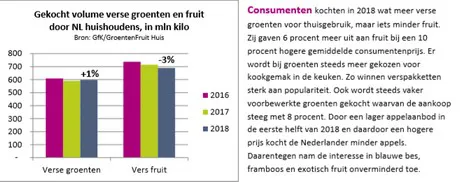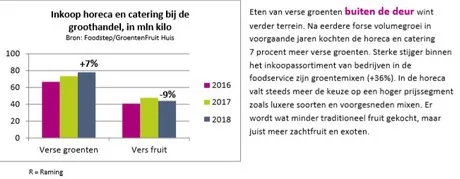In 2018, the Dutch bought more pre-treated vegetables and ate more fresh vegetables out of home. More and more Dutch people occasionally buy meal or soup kits. The catering industry and catering also choose convenience. The purchasing of vegetable mixes increased by 36 per cent in food service. In this case the following also applies: take the healthy choice, the easy choice.
In volume, the purchasing of fresh vegetables increased by seven per cent in catering. After considerable growth in volume in recent years, this means the percentage is now levelling off. Catering is choosing increasingly more luxurious products, such as premium varieties and pre-cut mixes. The explanation can be found in increasing pressure on chefs to have original menus without a lot of additional work. They also look at good portion sizes and less waste. Demand for blueberries and raspberries continues to grow, and caterers surprises their guests with mango more often as well.

The fruit and vegetable sector spends a lot of attention on a clear origin of products and the manner in which the products are produced. The sector pays attention to sustainable production and trade, food safety and fair labour conditions. After all, fruit and vegetables are good for you and for society.
More was spent on fruit and vegetables
In 2018, consumers spent five per cent more on fresh fruit and vegetables for at home. The Dutch bought slightly more volume in fresh vegetables (+1%), but less in fresh fruit (-3%). The average consumer price for a kilo of fresh fruit was ten per cent higher, so that expenses for fruit increased by six per cent. Apples in particular were more expensive due to low supply in the first half of 2018. Ten per cent fewer apples were bought because of that. This shows that product prices influence purchasing behaviour. Apples are good for 20 per cent of the total fruit purchases. The fruit and vegetable sector fears that the VAT increase on fruit and vegetables will have a negative effect on sales, particularly among consumers with less to spend. This group in particular has to catch up to consume the daily recommended amount of fruit and vegetables.

More expensive products
The Dutch also bought fewer oranges. On the other hand, interest in more expensive products such as soft fruit, exotic fruit and freshly cut fruit continued to increase. The warm summer had a positive effect on sales of salad vegetables, such as cucumber, tomato and bell pepper.
For more information:
Groentenfruit Huis
www.groentenfruithuis.nl
